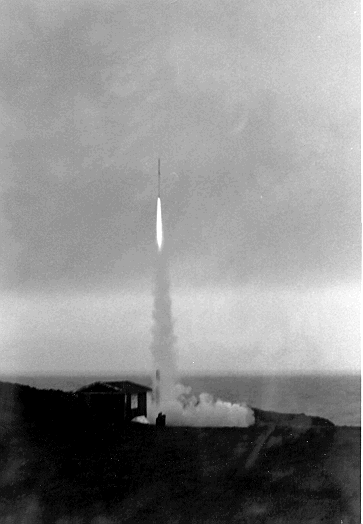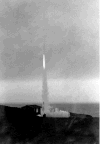
MetRockets -- Meteorological Rockets
I always enjoyed experimenting with rockets when I was younger. I was quite impressed
by the power of solid-fuel rockets, you know the little Estes rockets you'd see at the
hobby stores. Well imagine that same type of fuel -- but 30 pounds of it.
 |
.Same as title image, this one isn't mine. It was presented to me on the
dismantling of the program on Shemya in mid-1986. |
 |
The rocket shack and launch pad. If you look closely at the full size
image you can see the white rocket body loaded and waiting for countdown |
 |
Fishing boat seeking haven from a pending storm. I sure hope they knew
what was going on, a launch was quite noisy so even over the wind it could get your
attention. We were just at the upper limit on winds that day, I think the cutoff was at 50
knots or so. |
These things could move -- generally it was doing Mach 2 by the time it cleared the
launch rack. The rocket was made up of two stages, a six-foot booster stage with the 30
pounds of solid fuel that would burn off in just two seconds. The stages would separate
just after burn-out by means of an explosive charge and the three-foot payload stage would
continue to climb to about forty-five thousand feet. Then the nose cone (a 9 pound iron
weight -- wouldn't that just make a ship captain's day) would separate by means of another
explosive charge and soft brass shear screws and free-fall back to earth...guess why the
US Coast Guard had to ensure a clear range before every launch.
At that point a modified parachute, actually a starute, would deploy and hold an
instrumentation package aloft to measure temperature and humidity, alternately sending
each back to telemetry equipment on the ground. The starute was metallized mylar to be
radar reflective, and was tracked to determine wind speed and direction via differences in
measurements. I don't remember too much about the methods to reduce the data, but I know
it involved a bunch of charts on plotting boards and some pretty odd looking circular
slide-rules. It was all that two of us could do to keep each other accurate and on track.
I forget the schedule, but we launched them at pre-arranged times, in combination with
a Rawinsonde balloon launch. The day of a launch started at about 3:00am and went 'til
about 6:00pm. There was a lot of preparation, but the reduction of the data is what took
forever. We ended up with a short, one paragraph section of coded data for transmission to
the rest of the world. It always seemed rather anticlimactic.
I have some un-edited video tape of a launch taken by a film crew from Elmendorf AFB .
They were trying to get some footage for PR work and orientation for soon-to-be islanders.
It was one of my launches, so I show it to my kids every now and again. Real soon now,
I'll setup the Snappy to capture some frames and post them.